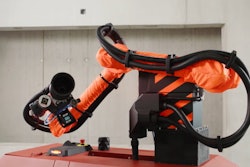
Emerging robotics technology may soon help construction companies and contractors create buildings in less time at higher quality and at lower costs.
Purdue University innovators developed and are testing a novel construction robotic system that uses an innovative mechanical design with advances in computer vision sensing technology to work in a construction setting.
“Our work helps to address workforce shortages in the construction industry by automating key construction operations,” said Jiansong Zhang, an assistant professor of construction management technology in Purdue's Polytechnic Institute. “On a construction site, there are many unknown factors that a construction robot must be able to account for effectively. This requires much more advanced sensing and reasoning technologies than those commonly used in a manufacturing environment.”
Watch the video of engineers working at Purdue's Polytechnic Institute:
Robotic Task Completion
The Purdue team’s custom end effector design allows for material to be both placed and fastened in the same operation using the same arm, limiting the amount of equipment that is required to complete a given task.
Computer vision algorithms developed for the project allow the robotic system to sense building elements and match them to building information modeling (BIM) data in a variety of environments, and keep track of obstacles or safety hazards in the system’s operational context.
“By basing the sensing for our robotic arm around computer vision technology, rather than more limited-scope and expensive sensing systems, we have the capability to complete many sensing tasks with a single affordable sensor,” Zhang said. “This allows us to implement a more robust and versatile system at a lower cost.”
The technology was developed with support from the National Science Foundation. Undergraduate researchers in Zhang’s Automation and Intelligent Construction (AutoIC) Lab helped create this robotic technology. The researchers worked with the Purdue Research Foundation Office of Technology Commercialization to patent the technology.
This work will be featured at OTC’s 2021 Technology Showcase: The State of Innovation. The annual showcase, being held virtually this year Feb. 10-11, will feature innovations from inventors at Purdue and across the state of Indiana.


















